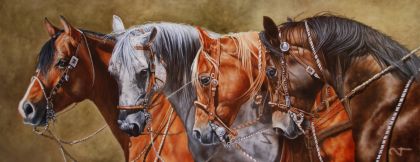Horse (domestic)
| Type | Riding | Draught | Pony |
| Species | hoofed mammal | ||
| No. Appearing | 1 | 1 | 1 |
| Behaviour | domesticated | ||
| Range | rural, urban | ||
| Size at the withers |
14-16 hands | 15-17 hands | 14 hands |
| Weight | 1,000-1,300 lbs. | 1,000-1,500 lbs. | 600-800 lbs. |
| Intelligence | 2 | 2 | 2 |
| Armour Class | 7 | 7 | 7 |
| Hit Dice | 2 | 3 | 1 |
| Action Points | 6 | 5 | 5 |
| Max. Stride | 17 | 12 | 14 |
| THAC0 | 20 | 19 | 20 |
| Hp/Die | d4+d6 | d4+d6 or d12 |
d106 |
| Attack Form | bite | ||
| Damage | 1-3 | 1-3 | 1-2 |
| Special Attack | back kick | none | |
Domestic Horses are adapted to run, allowing them to quickly escape predators. They possess an excellent sense of balance and a strong fight-or-flight response. Spirited, hot-blooded horses are bred for speed and endurance, finding work as warhorses, racehorses and for riding and driving. "Cold-bloods" are employed for slow, heavy work, particularly in agriculture and haulage. For these uses, domesticated horses are provided with feed, water and shelter, as well as care and shoeing.
Most horses in the world are purebreds, firstly because there is little transference of breeds between regions. Breeds tend to be known by their place of origin, having distinctive characteristics transmitted consistently to their offspring, such as colour, performance and disposition. Selective breeding is practiced locally, with breeds being developed to serve a particular function. Thus, the height and weight of horses comes from efforts made for hundreds of years to produce specific forms of horse.
Types
Riding Horses are used primarily for transportation and for pleasure. The chief means of travelling long distances for those who possess wealth and status, riding horses are also used for jumping, hunting and racing. They are used for constabulary work, for controlling herd animals and often as a means for a landowner to oversee their estates. Riding horses may be put to work for farming or as cart-horses, but as they tend to be warm or hot-blooded, they do not always have a suitable temperament for this type of work.
Draught Horses, or "drays," are employed most often as a cart-horse or plough horse, as these are horses bred to be a working animal doing hard tasks of drawing or helping to lift heavy loads. Aside from farming, they are used for logging, construction and haulage, among other uses. They're recognizable by their tall stature and extremely muscular build. They have a more upright shoulder, producing an upright movement and a conformation that is well suited for pulling. They have broad, short backs, with powerful hindquarters, and heavy bones with a good deal of feathering on their lower legs. They are calm, patient and deliberate in nature.
Ponies are small horses, being either a young horse, less than two years old, or bred deliberately to have a small size into adulthood. Bred ponies often exhibit thick manes, tails and coat, as well as proportionally shorter legs, wider barrels, heavier bone and thicker necks. Some ponies are used for mining, because their short height makes them practical for underground work. Ponies are considered intelligent and friendly; yearlings can be stubborn or cunning. There is no correlation between a horse's size and inherent athletic ability; a pony can do whatever a horse can do.
See also,
Bestiary
Horseback Riding
